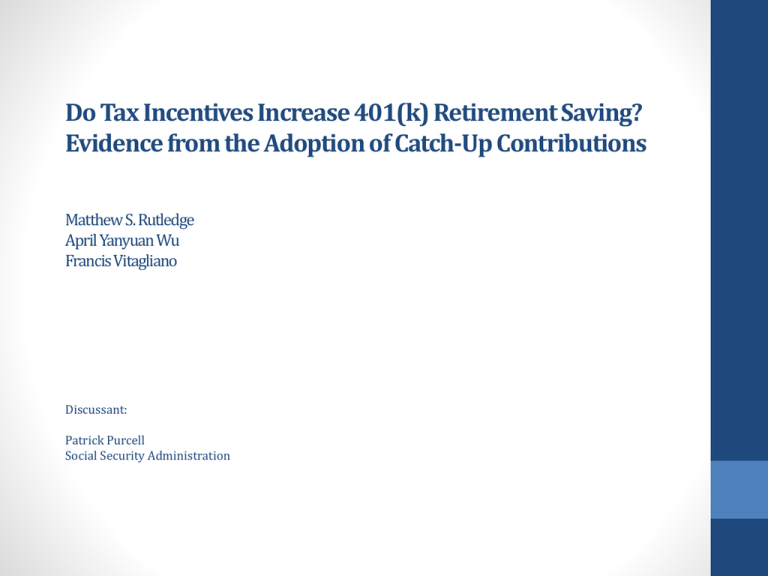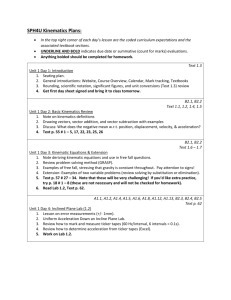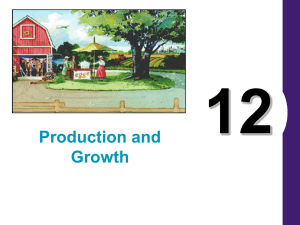Slides
advertisement

Do Tax Incentives Increase 401(k) Retirement Saving? Evidence from the Adoption of Catch-Up Contributions Matthew S. Rutledge April Yanyuan Wu Francis Vitagliano Discussant: Patrick Purcell Social Security Administration “Catch-up” Contributions • EGTRRA of 2001 allows “catch-up” contributions: Maximum 401(k) contribution in 2015 is $18,000. Workers 50 and older can contribute an additional $6,000. Rationale: People may not have saved enough for retirement when they were younger. They may need to save more as retirement approaches. “Catch-up” Contributions • The tax-deferred treatment of 401(k)-type plans cost the U.S. Treasury $61 billion in forgone revenue in 2014. (Joint Committee on Taxation) • However . . . . • “. . . researchers have not come to a consensus on whether this tax expenditure induces additional retirement saving.” “Catch-up” Contributions • Do 401(k) contributions increase saving? Poterba, Venti, and Wise (1995): 401(k) plans generate an increase in net retirement saving. Engen, Gale, and Scholz (1994): 401(k) savers shift saving to tax-deferred plans. They don’t save more. Engelhardt (2001): Very little of the average dollar of 401(k) wealth appears to be new household saving. Chetty et al. (2014): Tax expenditures do not increase total saving. Savers shift assets across savings plans. “Catch-up” Contributions • This study: Workers age 50 and over who had made the maximum deferral increased their annual contribution by $543 more than similar workers just under age 50. • However, “whether the increase in 401(k) contributions is a substitution from other accounts or an increase in total saving remains unclear.” “Catch-up” Contributions • The “catch-up” provision appears to have resulted in higher 401(k) contributions by the targeted population. • However, we do not know if these contributions are new saving or if the same amount would have been saved anyway. • Should we use tax-expenditures to increase 401(k) contributions by people already contributing the maximum when most people contribute much less – or nothing at all? “Catch-up” Contributions • Only about 9 percent of individuals in the sample had made 401(k) contributions within 10 percent of the annual maximum. • Those had who contributed within 10 percent of the maximum differed from the full sample: Maximum contributors earned about $163,000 compared to $57,000 for the full sample. Maximum contributors had mean net worth of $439,000, versus $200,000, for the full sample. “Catch-up” contributions • The catch-up provision might not be necessary as an incentive for older workers to save more. • Workers over 50 tend to save more than younger workers, regardless of tax incentives. • “Empirical evidence suggests that saving rates increased around age 50 between 0.5 and 1.2 percentage points, even before the adoption of catch-up contributions.” “Catch-up” contributions • Because the tax incentives for retirement saving rise in value with income (and marginal tax rate) they are sometimes said to be “upside down”. • Catch-up contributions apply to people who already save more than average: workers who contribute near the maximum and are over 50. • From the perspective of younger, lower-earning workers, the catch-up provision might appear to be both upside down and backwards. “Catch-up” contributions • Lower-income households are less sensitive to tax incentives. • They face lower tax rates, and many have no income tax liability after deductions and exemptions. • “Instead, more direct policy interventions, such as auto-enrollment tied to auto-escalation, are likely necessary to increase retirement saving for this group.” “Catch-up” contributions • Another policy option would be to make the “Savers Credit” a refundable tax credit. • This credit is worth up to one-half of the first $2,000 contributed to a 401(k) or an IRA. • In 2012, 6.9 million tax filers claimed credits totaling $1.2 billion. The average credit was $215 for joint filers and $127 for single filers. • Families who have no federal income tax liability might respond to a refundable tax credit. “Catch-up” contributions • Main take-away messages: • “The increase in 401(k) contributions for the 10 percent who are previously constrained may or may not have resulted in an increase in net retirement saving.” • “If it did, further research would be needed to understand whether this increase is sufficient to counteract the additional deadweight loss from the increase in the 401(k) tax expenditure.” Thank you.



